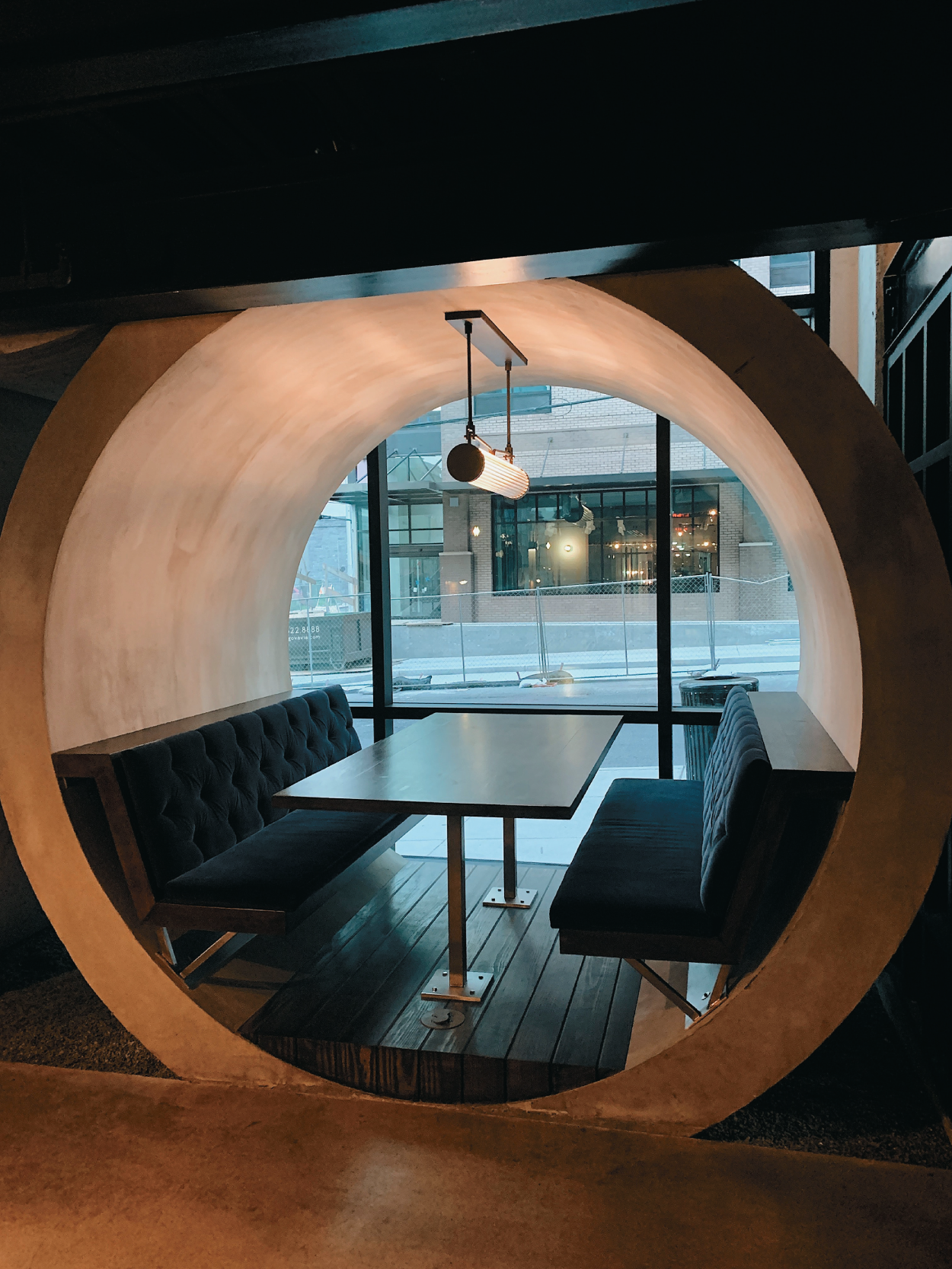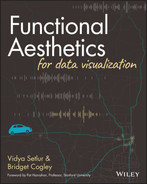Introduction
You enter the restaurant, escaping quickly from the cold. The large glass windows minimize the distance between the brisk air outside and the warm air inside. The generous wooden beams lead you deeper into the hubbub of the restaurant, until you find your sweet spot, the highly coveted booth embedded in a tube similar to the one in Figure 0.1. The space is playful and inviting. The table is almost spartan, but the lighting, the slightly raised platform, and the delightful paradox between the openness of the window and the intimacy of the space draw you in. You and a few friends step eagerly into the booth, awaiting the dining experience you've read about.

FIGURE 0.1 A view into a restaurant space
You take in the aesthetics of the space as you wait for your server. The concrete around you forms a perfect circle. The wooden flooring supports your feet as you gently tap them in anticipation. The light above emits a warm glow, suspended from the top and allowing light to fill the whole chamber. It's surprisingly warm, the velveteen seat cushions softly supporting you. The architecture is open, but you're nestled comfortably away from the noise. You laugh, feeling both free and cozy.
The meal arrives, served in a beautifully arranged black-lacquered bento box similar to what is seen in Figure 0.2. One of the visceral pleasures of the lunch box is the arrangement. The intentionality of the food placement is juxtaposed with the sheer beauty of the delicacies. There is a state of delicate tension as each dish gets its space with a deliberate order that helps guide your culinary experience. The food is separated, no sauces mixing, and the wasabi and ginger are placed where they can easily be pinched with chopsticks and added to the sushi. The main dish occupies the largest container. A supporting dish of cooked vegetables sits with the pickled condiment. Salad and sides are placed in smaller containers acting as cheerful companions to the protagonists of the meal. The black framing neatly highlights the shape of each part and provides an implicit guideline for order and hierarchy. The meal is a delight, with each varied piece harmoniously playing an essential part that is functional yet aesthetic.

FIGURE 0.2 Arrangement of food in a bento box
These are the experiences we hope to provide our users, one that balances form with function and delight with efficiency. It's leveraging beauty to provide both a form and function that support an ideal. While crafting charts and dashboards to help people see and understand data, we often spend time trying to find the right balance between a functional design and an aesthetically pleasing design that breaks through the clutter and noise. Functionality is often thought to be obvious; graphics have a functional purpose, which is to make it easy for the reader to understand the patterns in the data. The aesthetic component is less obvious. How do we make charts visually delightful in a way that takes the process of visual analysis to a whole new level of joy? The aesthetics are seen instantly. The charts indicate that the visualization author is skilled. They hint that the design is also functional. The joy of the aesthetics also compensates for the daunting aspects of data work. This visceral feeling is something that we can actually relate to in our own lives through the sights, sounds, and smells of the world as we experience it. The challenge, of course, is that aesthetic design is hard to achieve, hence this book.
Imagine in our restaurant scenario, and you head to the restroom just before leaving. After washing your hands, you go to grab a paper towel. The paper towel dispenser is one of those automatic ones and you wave your hands to no avail. Finally, it spits out the tiniest bit of paper. It's not even sufficient to grab, and so you dry off your hands on your clothing.
The paper towel problem is common. It comes wrapped with the best of intentions, from reducing waste to eliminating the need to touch anything, yet it falls short. The intents compete—we want people to use fewer paper towels, but they still need to be accessible. Too often, inaccessibility wins and dysfunctional behavior ensues. We end up using more, not less, or none at all.
This experience happens with data visualization as well. We create charts and our users flail when the intentions of the chart and that of the user do not align. They struggle to navigate our carefully laid dashboards, tidy explanations, and lovely frames. In short, we've done everything right, but it's still landing wrong. Just as with paper towels, our charts can fall short in ways we don't anticipate. They include hidden barriers—often chosen more to preserve an aesthetic or meet a certain goal than to provide a function—making it far too easy to do or interpret the wrong thing.
This is not a design book about charts.
Rather, it's a book focused on how the intentionality of the data in the chart can be expressed through thoughtful design sensibilities. The book explores the interplay between what we see (perception), what information is encoded (semantics), and what we mean (intent). Combined, this triad creates a powerful subsystem in the production of data-driven graphics. We call this concept functional aesthetics as a way of using beauty and form to guide and support function. Throughout this book, we'll highlight that charts are more than just visual artifacts; they come embedded with hidden linguistic components and interactivity that we can use to more clearly articulate our intent.
If you've picked up this book, we're assuming that beyond choosing effective charts, you're looking for ways to improve how your visualizations communicate. This could be presented as a traditional dashboard or as a data-driven app. It might be as an infographic or through data journalism. You might also be developing the next tool to help facilitate the making of data-driven graphics, as either a researcher or developer. Wherever you are using data to create an experience, we hope this book will help you move beyond literal chart making to semantically resonant data-centric creations. Legends, text, spacing, and so many hidden elements dictate how your work is read. This book is designed around that larger experience, so we're assuming you have a level of comfort with chart selection and statistically accurate data representation.
In this book, we'll center on the idea of data-driven experiences and how we can use functional aesthetics to both transport and cue our readers to the actions and insights we hope they'll take. We'll incorporate delight as a reasonable benchmark. Elegant design vanishes, becoming a backdrop in our memories and leaving us with a frictionless experience. We recognize it in physical spaces with a near-reverence for the place, as we saw with the restaurant example. Viscerally, we feel it, such as when we find a kitchen item stored just exactly where we'd put it, or a chair nestled in the perfect place to sit and enjoy the sunlight. Experiences delight and transcend the sum of the parts.
This book is also a conversation, one held between a researcher and a practitioner. We hope to challenge our own assumptions and to explore this subsystem deeper. Vidya Setlur, a researcher, has spent years investigating and integrating linguistics into her work, including Ask Data, a search engine within Tableau designed to display charts in semantically resonant ways. Bridget Cogley, a practitioner, has spent well over a decade working in data analysis and visualization. In addition to consulting experience centered on visualizations that captivate, she draws from her background interpreting American Sign Language to incorporate semantics in visualization. Our backgrounds form two sides of a coin: what the research says about our ideas and how they can reasonably be incorporated into practice for better results.
A Fiat, Food, and Finding Commonality

It all started in a Fiat, headed to Milwaukee to attend a local TUG event.
Vidya sat tucked in the backseat, suitcase nearby. Bridget sat in the front passenger seat while her husband drove. Prior to this trip, Vidya and Bridget had spoken only briefly. They had finished delivering their presentations in Madison the day before and were preparing to repeat them again in Milwaukee. Vidya presented on color theory and semantics, while Bridget discussed the logic of dashboards. Together, these sessions represented two pieces of a puzzle—how semantics and visual aesthetics together help people see and understand their data.
One hundred twenty miles and a lunch later, a friendship started, and so did this book.
As we have this conversation, both with you and ourselves, we also want to expose where ideas in this book originate. Are they researched with specific points proven, a theory that's perhaps still evolving, or perhaps a common practice that stems from practitioner experience or trend-following? Throughout the book, we will use the following visuals to highlight where these ideas reside.
Through this visualization, we hope to make easier to understand what's explicitly researched, what's sometimes extrapolated from that research, and what's potentially thought but not fully proven scientifically. Here's how you'll see the triangles used in the book:
This book is a continuation of that conversation started in the car, a dialog between a researcher and a practitioner. It is a means to examine all the knowledge we have across a number of disciplines and find ways to integrate them holistically into a system of practice. Throughout this book, we will discuss research, current working theories, and how these concepts can be implemented in practice.
This Book at a Glance
This book isn't designed to be an introduction to data visualization. We assume that you have read various introductory books, have a plethora of chart choosers, and are looking to move to that next level in data visualization. Maybe you're struggling with endless feedback cycles or seeking novel ideas in how to approach unifying charts into a cohesive unit. You might be an analyst, a researcher, or a professional in a dedicated field comfortable with visualizing statistics. Maybe you're in marketing and looking to shift the paradigm in how infographics are designed. Beyond charts, we hope this book challenges you to look at data in a new light, a view where charts construct part of a data message and that perception, semantics, and intent inform how visuals are understood.
While many examples in this book are designed in Tableau, we intend that the principles presented can be used in any software or programming language. This book is not designed to walk you through code snippets or the making of a particular chart or dashboard. Instead, it's a conceptual challenge and a paradigm shift.
We hope this book is a dialog, one that introduces ideas and a philosophy to design.
Here's how this book is structured.
 PART A: Visual Perception
PART A: Visual Perception
Part A will focus on perception and common practice. As the dominant dialog in academic and practitioner circles most frequently centers on perception, we will cover this lightly and reference other resources. We will first discuss how the human visual system is extremely adept at processing visual information such as color, shape, and size. By encoding data in these visual attributes, visualization tools offload cognitive work to the perceptual system, enabling users to focus on answering questions about their data rather than reading and comparing data values. We will then delve into common practice, such as the creation of charts and dashboards. We will also explore interaction patterns on the authoring side as well as for consumption.
 PART B: Semantics
PART B: Semantics
Semantics is the study of meaning. Language is a way of expressing and elucidating meaning in various ways; it makes use of a wide range of linguistic tools such as words, intonation, imagery, and gestures. In Part B, we explore how semantics can communicate visual expression through well-designed dashboards, effectively conveying the goals of the author to their audience as well as understanding the analytical goals of the user during data exploration. We will describe practitioner and researcher perspectives on how understanding the meaning of data and what it represents can in turn, help inform aesthetic yet useful ways of visualizing the data. In the next unit of the book, we will discuss in more detail what these analytical goals are, what we refer to as intent.
 PART C: Intent
PART C: Intent
A user expresses an information need as an intent when interacting with another human or with a computer system. Humans are particularly skilled at attempting to understand or seek clarification of an intent that is expressed. However, humans and computers have asymmetric and complementary skills, particularly in the areas of data, semantics, and aesthetics. Also, human-to-machine interaction can be particularly challenging as the human's and computer's mental models of what they would like to seek needs to be expressed and interpreted clearly. Part C will walk through various techniques for designing analytical conversations between data and the human in relation to their intent.
 PART D: Putting It All Together
PART D: Putting It All Together
As we step into the last section of the book, we will discuss how perception, semantics, and intent come together as a whole. Revisiting concepts from previous chapters, we provide key takeaways to help empower the reader, that’s you.
Let's dig in.
Reader Support for This Book
Companion Files
As you read through this book, references are included for supporting material. You can find a bibliography of these references on the support page for this book at www.wiley.com/go/fafordataviz. Additional information about the book, including a glossary of terms, newsletters, and regular updates about the book can be found at www.functionalaestheticsbook.com.
How to Contact the Publisher
If you believe you've found a mistake in this book, please bring it to our attention. At John Wiley & Sons, we understand how important it is to provide our customers with accurate content, but even with our best efforts, an error may occur.
In order to submit your possible errata, please email it to our Customer Service Team at [email protected] with the subject line “Possible Book Errata Submission.”
